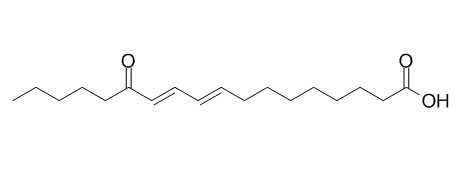13-Oxo-9E,11E-octadecadienoic acid
13-Oxo-9E,11E-octadecadienoic acid has antitumor activity.
Inquire / Order:
manager@chemfaces.com
Technical Inquiries:
service@chemfaces.com
Tel:
+86-27-84237783
Fax:
+86-27-84254680
Address:
1 Building, No. 83, CheCheng Rd., Wuhan Economic and Technological Development Zone, Wuhan, Hubei 430056, PRC
Providing storage is as stated on the product vial and the vial is kept tightly sealed, the product can be stored for up to
24 months(2-8C).
Wherever possible, you should prepare and use solutions on the same day. However, if you need to make up stock solutions in advance, we recommend that you store the solution as aliquots in tightly sealed vials at -20C. Generally, these will be useable for up to two weeks. Before use, and prior to opening the vial we recommend that you allow your product to equilibrate to room temperature for at least 1 hour.
Need more advice on solubility, usage and handling? Please email to: service@chemfaces.com
The packaging of the product may have turned upside down during transportation, resulting in the natural compounds adhering to the neck or cap of the vial. take the vial out of its packaging and gently shake to let the compounds fall to the bottom of the vial. for liquid products, centrifuge at 200-500 RPM to gather the liquid at the bottom of the vial. try to avoid loss or contamination during handling.
Molecular & Cellular Toxicology2022, 10.1007:s13273-022-00277-3
Mol Neurobiol.2023, 60(12):7196-7207.
Chinese J of Tissue Engineering Res.2022, 26(17): 2636-2641.
Food Chem.2021, 360:130063.
Cells.2021, 10(10):2633.
Nutrients.2024, 16(20):3521.
Nutrients.2021, 13(12):4364.
Genes (Basel).2021, 12(7):1024.
Functional Ecology2020, doi: 10.1111.
Chem Pharm Bull (Tokyo).2019, 67(11):1242-1247
Related and Featured Products
Journal of Chromatography A, 2017, 1487:162-167.
Screening and analysis of potential anti-tumor components from the stipe of Ganoderma sinense using high-performance liquid chromatography/time-of-flight mass spectrometry with multivariate statistical tool.[Reference:
WebLink]
According to Chinese Pharmacopoeia 2015 edition, Ganoderma (Lingzhi) is a species complex that comprise of Ganoderma lucidum and Ganoderma sinense. The bioactivity and chemical composition of G. lucidium had been studied extensively, and it was shown to possess antitumor activities in pharmacological studies. In contrast, G. sinense has not been studied in great detail. Our previous studies found that the stipe of G. sinense exhibited more potent antitumor activity than the pileus.
METHODS AND RESULTS:
To identify the antitumor compounds in the stipe of G. sinense, we studied its chemical components by merging the bioactivity results with liquid chromatography-mass spectrometry-based chemometrics.The stipe of G. sinense was extracted with water, followed by ethanol precipitation and liquid–liquid partition. The resulting residue was fractionated using column chromatography. The antitumor activity of these fractions were analysed using MTT assay in murine breast tumor 4T1 cells, and their chemical components were studied using the LC-QTOF-MS with multivariate statistical tools. The chemometric and MS/MS analysis correlated bioactivity with five known cytotoxic compounds, 4-hyroxyphenylacetate, 9-oxo-(10E,12E)-octadecadienoic acid, 3-phenyl-2-propenoic acid, 13-Oxo-9E,11E-octadecadienoic acid and lingzhine C, from the stipe of G. sinense.
CONCLUSIONS:
To the best of our knowledge, 4-hyroxyphenylacetate, 3-phenyl-2-propenoic acid and lingzhine C are firstly reported to be found in G. sinense. These five compounds will be investigated for their antitumor activities in the future.



